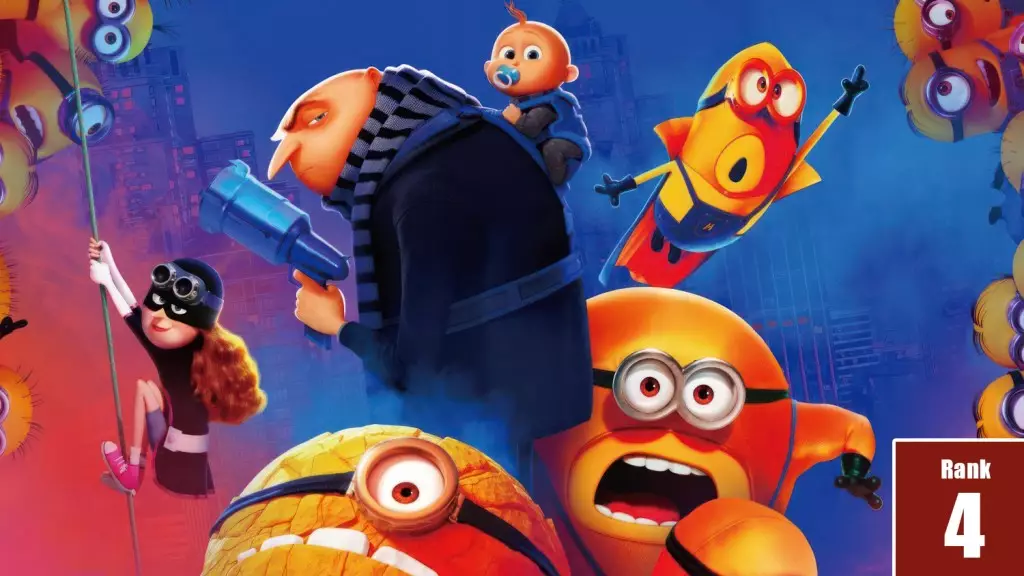The film industry is continuously evolving, influenced heavily by the rapid rise of streaming services and shifting audience preferences. The recent return of Deadline’s Most Valuable Blockbuster tournament has brought these dynamics into sharp focus, showcasing not only the earnings from box office sales but also emphasizing downstream revenues. In a time when figures can mislead, understanding the broader financial structure of films is essential, especially in a world where streaming often plays both judge and jury over a film’s success. The absence of platforms like Apple and Amazon in this year’s analysis highlights a notable trend: traditional box office metrics do not fully capture the complexities of modern cinematic economics.
The Power of Proven Franchises
Among the standout films of 2024, “Despicable Me 4” has emerged as an undeniable titan at the box office. Celebrating its 15th year, the franchise has not only captivated young audiences but also secured the affection of parents who have grown up with Gru and the Minions. Last year, it broke barriers, pushing the franchise past the staggering $5 billion mark, making it the first animated series to reach this monumental milestone. This is not merely a story about animated characters, but a testament to the power of nostalgia and continuity in drawing audiences back into theaters time and again.
The introduction of new characters, like baby Gru Jr. and villain Maxime Le Mal, enhanced the narrative strength of the film, revitalizing its familial themes while infusing fresh humor. The strategic decision by Universal to invest heavily—dropping $170 million on a global marketing spree—demonstrates a profound belief in their product. Such a robust campaign, spanning enormous events and leveraging cultural moments, illustrates the potent mix of marketing prowess and audience engagement that is necessary in today’s film landscape.
Cultural Relevance and Strategic Marketing
It’s not just the characters but their cultural relevance that keeps people engaged. Universal managed to blend Gru and the Minions into pop culture seamlessly, igniting viral moments that added buzz beyond film trailers. For instance, an NBA player arriving at a playoff game dressed as Gru garnered more than 66 million views—proof that the characters resonate deeply across demographics. The strategic deployment of pop culture references, including AI-themed jokes during the Super Bowl, shows how integral cultural touchstones are in capturing audience attention and fostering communal viewing experiences.
Furthermore, pop-up stores and collaborations, such as those with BTS, positioned the franchise at the forefront of youth culture, creating an immersive experience that transcended traditional cinema. This innovative approach to marketing isn’t just about selling tickets; it’s about weaving the film’s narrative into the fabric of contemporary life.
Cost-Effectiveness in Animation
Better yet, Universal’s management of production costs is remarkably efficient, especially considering that “Despicable Me 4” was developed with a budget of only $100 million. That is relatively economical for a big animation release, showcasing Illumination’s reputation for balancing quality and cost. This efficiency allows for a more significant portion of revenue to translate into profit. With a reported net profit of $370 million after a global haul of $775 million and total expenses of $405 million, it’s evident that savvy management and creative talent have crafted a perfect storm of success.
In an age where animated films often escalate in expenditures, “Despicable Me 4” serves as a case study for how to balance ambition with fiscal responsibility. In stark contrast to industry trends of inflated budgets, this achievement reflects an adherence to sound business strategies in an ever-competitive environment.
Lessons for the Future of Animation and Film
While “Despicable Me 4” stands as a single testament to Universal’s prowess, it provides broader lessons for the film industry at large. The intersection of engaging storytelling, robust marketing strategies, and cultural relevance is crucial. In today’s world, merely releasing a film into theaters isn’t enough; embedding it into the cultural zeitgeist while maintaining responsible finances may very well determine the winners and losers in future box office showdowns.
To thrive in an ever-changing cinematic landscape, studios must not only understand the mechanics of box office revenues but also foster a dynamic relationship with audiences—ultimately revitalizing the theatrical experience. As “Despicable Me 4” demonstrates, the future of animation could very well depend on an integrated approach that respects both art and commerce.

